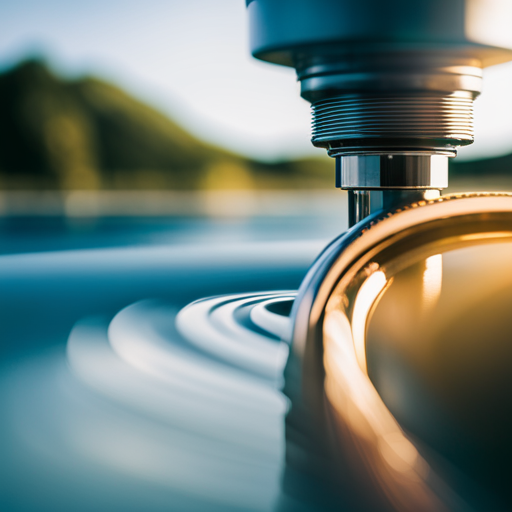Do you want to ensure that your drinking water is safe and free of harmful contaminants? Look no further than reverse osmosis filters! These filters are an easy and effective way to purify your water and ensure that you are consuming only the best quality of water.
In this article, we will guide you through the various components of a reverse osmosis filter and explain how they work together to produce clean and safe water for you and your family.
The reverse osmosis filter consists of pre-filters, a membrane, and post-filters that work together to remove impurities from your water. The pre-filters remove larger particles and sediments from your water, while the membrane acts as the heart of the filter, removing contaminants such as lead, arsenic, and fluoride. The post-filters then remove any remaining impurities and improve the taste and odor of your water.
By understanding the components of a reverse osmosis filter, you can make an informed decision about the best filter for your home and ensure the safety of your drinking water.
Key Takeaways
– Reverse osmosis filters consist of pre-filters, a membrane, and post-filters to remove larger particles, contaminants, and improve taste and odor.
– Total dissolved solids (TDS) can impact taste and quality, but reverse osmosis membrane can reject up to 95% of TDS.
– Optional accessories like remineralization filter, UV disinfection light, or TDS monitor can enhance performance and quality by adding healthy minerals, sterilizing water, and measuring water quality.
– Proper installation and maintenance of optional accessories can greatly improve the performance and quality of the reverse osmosis system.
Pre-Filters and Membrane
You need pre-filters, like sediment and carbon filters, to remove contaminants, and a reverse osmosis membrane that rejects 95% of TDS for clean water.
The sediment filter removes large particles like sand, dirt, and rust, while the carbon filter removes chemicals like chlorine, pesticides, and herbicides. These pre-filters ensure that the reverse osmosis membrane can function properly and last longer by reducing the load of contaminants it needs to remove.
The reverse osmosis membrane is the heart of the filtration system. It uses pressure to force water molecules through a semi-permeable membrane that blocks contaminants like bacteria, viruses, and dissolved minerals.
TDS, or total dissolved solids, are measured by the concentration of mineral ions in water and can impact taste, odor, and quality. The reverse osmosis membrane can reject up to 95% of TDS, so you can enjoy clean and fresh-tasting water.
Post-Filters and Accessories
To enhance the performance and quality of your reverse osmosis system, consider adding optional accessories such as a remineralization filter, UV disinfection light, or TDS monitor. A remineralization filter can add healthy minerals back into the water, improving taste and providing additional health benefits. A UV disinfection light can kill bacteria and viruses, ensuring that your drinking water is safe and clean. A TDS monitor can measure the concentration of dissolved solids in the water, allowing you to track the effectiveness of your filtration system.
Installation tips for optional accessories may vary depending on the specific product, so it is important to follow the manufacturer’s instructions carefully. Maintenance requirements may also differ for each accessory, so be sure to regularly inspect and clean them as needed. With proper installation and maintenance, these optional accessories can greatly enhance the performance and quality of your reverse osmosis system. Check out the table below for a summary of the optional accessories and their benefits.
| Accessory | Benefits |
|---|---|
| Remineralization Filter | Adds healthy minerals back into the water, improving taste and providing additional health benefits |
| UV Disinfection Light | Kills bacteria and viruses, ensuring that your drinking water is safe and clean |
| TDS Monitor | Measures the concentration of dissolved solids in the water, allowing you to track the effectiveness of your filtration system |
Optional Enhancements
Consider enhancing the performance and quality of your RO system with optional features. You can add a remineralization filter, UV disinfection light, or TDS monitor to cater to your specific water treatment needs. These components bring additional benefits to your RO system.
A remineralization filter adds healthy minerals to the water, making it more beneficial for your health. It helps to re-balance the pH levels and improve the taste of the water.
The UV disinfection light is a powerful tool to prevent bacteria and viruses from contaminating your water. It sterilizes the water by killing harmful microorganisms and making it safe for consumption.
Additionally, the TDS monitor measures the dissolved solids concentration in the water. It gives you an idea of the quality of your water and the effectiveness of your RO system. These optional components can provide you with added peace of mind and assurance that your RO system is performing at its best.
Conclusion
Congratulations! You now have a better understanding of the components that make up a reverse osmosis filter and how they work together to produce clean and safe drinking water.
By incorporating pre-filters and a membrane, your filter can effectively remove contaminants and impurities from your water. Additionally, post-filters and accessories can further enhance the quality of your water by removing any remaining particles or adding beneficial minerals.
If you’re looking to take your water filtration to the next level, consider adding optional enhancements such as a UV sterilizer or remineralization cartridge. These features can provide additional peace of mind and ensure that you are getting the purest and healthiest water possible.
With a reverse osmosis filter, clean and safe drinking water is just a few simple steps away. So go ahead, take the plunge, and start enjoying the benefits of a high-quality water filtration system today!




